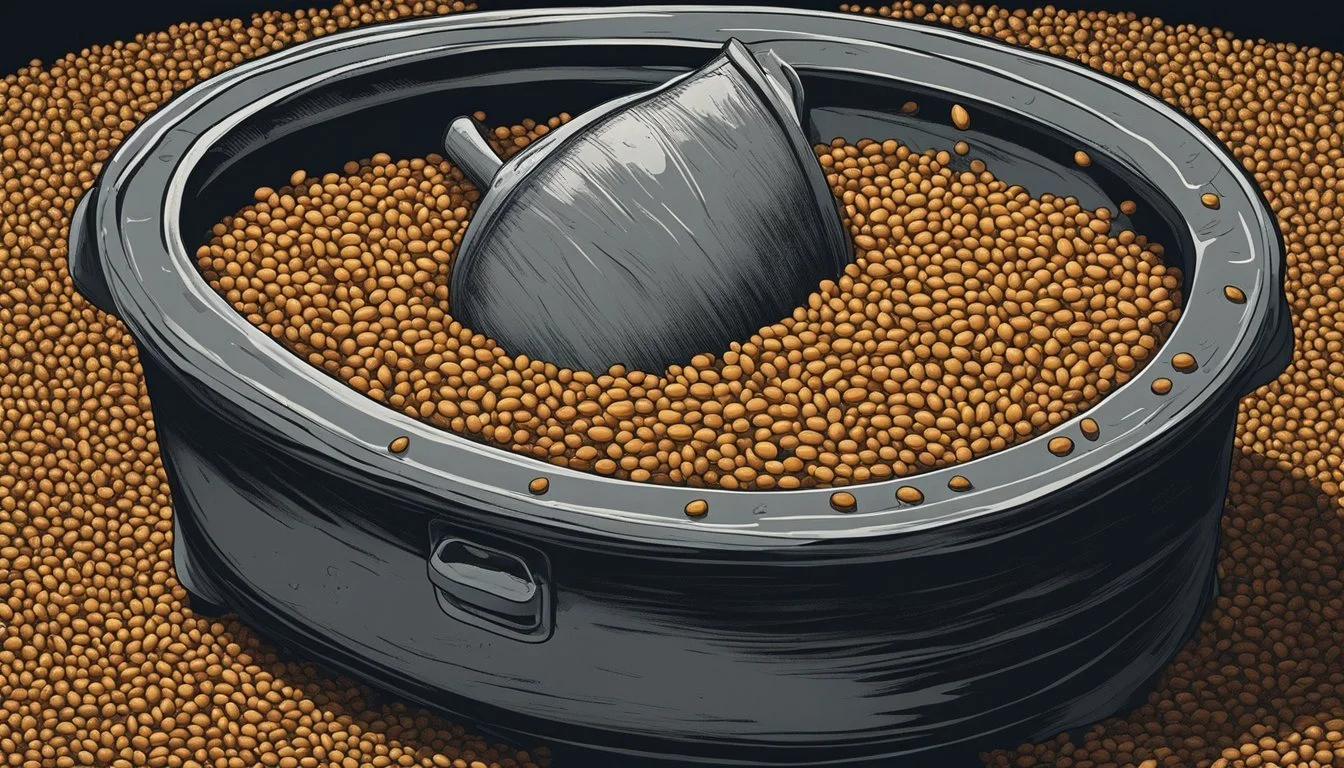How to Ferment Doubanjiang
Mastering Chinese Fermented Bean Paste at Home
Doubanjiang, a spicy bean sauce originating from the Sichuan province in China, plays an essential role in the region's iconic cuisine. This paste is composed of fermented soybeans, broad beans, salt, and chili peppers, acquiring a unique savory, salty, and slightly spicy flavor profile as it ages. The fermentation process not only deepens the sauce's complexity but also imparts an umami-rich taste that is integral to many Chinese dishes.
The making of doubanjiang is a time-honored tradition that begins with the selection of quality ingredients which are then combined and left to ferment. The fermentation period can vary, but it often spans several months to several years, during which the mixture matures under careful conditions. This artisanal technique results in a paste characterized by its intense aroma and deep reddish-brown hue, distinguishing it from other condiments.
The use of doubanjiang is prevalent in Sichuan cooking, where its depth of flavor is a testament to the region's culinary heritage. It serves as the base for a variety of recipes, including the well-known mapo tofu, where its spicy and salty notes breathe life into the dish. The paste's versatility and potent taste make it a staple in the pantries of those who appreciate the richness of Chinese gastronomy.
History and Origin of Doubanjiang
Doubanjiang, the quintessential seasoning of Sichuan cuisine, has a rich legacy intertwined with Chinese culinary traditions. Its development is rooted deeply in the gastronomic practices of the Sichuan region.
Sichuan's Culinary Tradition
Sichuan cuisine, known for its bold flavors, often incorporates Doubanjiang, which is a testament to the paste's historic significance in the area. The paste is made from fermented broad beans, chili peppers, soybeans, salt, and flour, and it is celebrated for contributing a complex, savory depth to dishes. The traditional fermentation process, critical for achieving the signature taste, involves the paste fermenting under the sun for periods that can extend from one month to several years, depending on the specific recipe or artisanal technique.
Pixian Doubanjiang
Specifically, Pixian Doubanjiang is highly esteemed and is often referred to as the "soul of Sichuan cuisine." Pixian, a county near Chengdu, is renowned for producing the most authentic and high-quality Doubanjiang. The region's unique climate provides optimal conditions for the fermentation process that Pixian Doubanjiang undergoes. Pixian Douban, as it's sometimes called, has a long-standing reputation, often being aged longer than other varieties to intensify its flavor—making it an indispensable ingredient in numerous Sichuan recipes.
Ingredients and Varieties
The cornerstone of Doubanjiang lies in its primary ingredients: broad beans and chili peppers, which contribute to its distinctive umami flavor. Alongside these, regional variations incorporate different spices and techniques, offering a variety of flavor profiles and uses in culinary applications.
Broad Beans and Chili Peppers
Key Ingredients:
Broad Beans (Fermented): The base for traditional Doubanjiang, broad beans are fermented to develop the rich, savory flavor associated with the paste.
Chili Peppers: These are blended with the fermented broad beans to add heat and complexity to the paste.
Preparation Process:
Fermentation of Broad Beans: After soaking, the broad beans are usually combined with flour and left to ferment, developing the initial layers of flavor.
Addition of Chili Peppers: Post fermentation, the beans are mixed with salt and chili peppers, sometimes combined with a small amount of oil, to intensify the paste's spicy and umami characteristics.
Regional Variations and Substitutes
Regional Differences:
Sichuan Doubanjiang (Spicy Doubanjiang): It's known for its bold, spicy profile, primarily made with fermented broad beans, chili peppers, and salt. Additional ingredients may include various spices which add to its depth of flavor.
Other Regions: Some regions may use fermented soybeans or a combination of soybeans and broad beans to create nuanced flavor profiles or alter the spice level.
Substitutes:
Gochujang: A Korean condiment that is sometimes used as a substitute, though it has a sweeter taste and smoother texture.
Black Bean Paste and Fava Bean Paste: While they can serve similar purposes in certain dishes, they offer different flavor profiles and cannot replicate the unique taste of Doubanjiang.
Preserved Fava Bean Paste: This is a closer alternative, also utilizing fermented fava beans, but it may have a different spice composition.
When seeking a Doubanjiang substitute, consider the desired flavor impact on the dish and the presence of umami, salt, and spice. Each alternative will bring a different dimension to the recipe, while keeping in mind that Doubanjiang's singular taste is irreplaceable.
The Fermentation Process
The fermentation process of Doubanjiang is crucial in developing its characteristically pungent, umami flavor. It involves meticulous preparation and specific fermentation conditions that span over months.
Preparation Techniques
Before fermentation begins, one must prepare a mixture of broad beans and soybeans. These legumes form the base of Doubanjiang. They are soaked, typically overnight, to soften, and then cooked until tender. After cooking, the beans are mashed into a paste and then combined with flour. This mixture acts as a food source for the koji mold spores (typically Aspergillus oryzae), which are integral to the fermentation process. The spores are evenly distributed throughout the paste.
Next, the mixture is shaped into small bricks or balls and left to dry slightly in a cool, airy place to provide the perfect environment for the koji mold to develop. Once a fine white mold coating appears on the surface, it indicates that the koji has propagated successfully, and the next stage of fermentation can commence.
Fermentation Time and Conditions
The fermentation of Doubanjiang is a long-term process that takes several months to several years, depending on the desired outcome. The microorganisms need a warm, humid environment to thrive, so the fermentation time greatly varies with regional climate conditions and the specific taste profile being targeted.
Initial Stage: The koji-inoculated beans are mixed with salt and chili peppers. This mixture is then transferred to earthenware pots or wooden containers.
Aging: The pots are covered with a cloth to allow air circulation while keeping out external contaminants. They are placed in an area where they can be periodically exposed to sunlight to maintain an optimal temperature.
It's important to periodically stir the contents of the pots to ensure even fermentation and to prevent the development of undesirable molds. Constant monitoring and adjustment of salt levels is vital, as it inhibits harmful bacteria while promoting the growth of desirable lactic acid bacteria.
As fermentation progresses, the paste matures, developing its uniquely pungent aroma and deep, complex umami flavor. After reaching the desired maturation, the Doubanjiang is ready for use in cooking or can be stored for further aging, which can further enhance its flavor profile.
Culinary Uses
Doubanjiang, often referred to as the soul of Sichuan cuisine, is a versatile ingredient identified for its pungent and salty flavor profile. Its unique taste is utilized in various dishes ranging from powerful stir-fries to rich stews, adapting well with other components to create a symphony of flavors.
Sichuan Cooking Applications
In traditional Sichuan cooking, Doubanjiang is the cornerstone ingredient in many iconic dishes. Mapo Tofu, a famous recipe, relies on this fermented bean paste for its signature fiery taste, while Twice-Cooked Pork harnesses the deep, savory elements it brings. It's commonly used for stir-fries, where just a spoonful can transform vegetables and meats with its robust character. Doubanjiang also enhances the flavor foundations in Sichuan beef noodle soup, providing a complexity that is hard to replicate with other condiments.
Stir-fry: A staple in Chinese cooking, Doubanjiang is often mixed with sesame oil or hot oil to release its flavors before adding it to the wok.
Soups & Stews: Its savory notes complement broths and stew bases, adding depth alongside ingredients like oyster sauce and soy sauce.
Marinades: For meat seasoning, it pairs well with miso or hoisin sauce to create a robust marinade.
Doubanjiang in International Cuisine
As global palates have embraced Sichuanese flavors, Doubanjiang has found its way into international cuisine. Variants such as Korean Gochujang or Indonesian Sambal Oelek share similarities with it but incorporate regional twists. The international kitchen experiments with Doubanjiang in marinades, incorporating it alongside ingredients like oyster sauce and sesame oil, to create a fusion of traditional and modern flavors. Additionally, it can serve as a substitute for hot sauce in noodle dishes or as an untraditional spicy seasoning in dumpling fillings, exhibiting its adaptability beyond Chinese borders.
Condiment Substitution: Doubanjiang can replace or work with other sauces like sambal oelek or miso to provide a unique kick.
Fusion Dishes: Chefs around the world are using this Sichuan paste to innovate cross-cuisine dishes, adding a tantalizingly spicy twist.
Nutritional Information and Health Benefits
Doubanjiang, a Chinese fermented bean paste, offers a rich savory taste known for its umami flavor profile. Its primary ingredients, fermented broad beans and soybeans, contribute essential nutrients to one's diet. The fermentation process is also noteworthy for enhancing the bioavailability of these nutrients, which supports digestive health.
Nutritional Content
Protein: The soybeans in doubanjiang are a source of plant-based protein, which is crucial for muscle repair and overall health.
Fiber: This condiment provides dietary fiber, instrumental in maintaining a healthy digestive system.
Vitamins: Fermented foods such as doubanjiang contain B vitamins, particularly vitamin B12, which is often found in animal products and less so in plant-based foods.
The salt used in the fermentation process creates a salty flavor, but it also contributes sodium to the paste. While sodium is necessary for bodily functions, it should be consumed in moderation.
Health Benefits
Gut Health: The fermentation of broad beans and soybeans results in the development of probiotics, which are beneficial for one’s gut flora.
Metabolism: The protein and fiber content in the paste can help promote a feeling of fullness and aid in metabolism.
Heart Health: Moderate intake of fermented soy products has been associated with improved cardiovascular health.
Consuming doubanjiang as part of a balanced diet can introduce a unique savory flavor to dishes while contributing positively to one’s nutrition. However, due to its high salt content, individuals should use it sparingly, particularly those monitoring sodium intake for health reasons.
Purchasing and Storage
When looking for Doubanjiang, one should ensure they're choosing a high-quality product and understand the proper storage methods to preserve its flavor and longevity.
Selecting Quality Doubanjiang
Purchasing quality Doubanjiang is the first step in enjoying its rich flavors. Consumers can find various brands online, including on Amazon. One should look for pastes with vibrant color and a balance of spicy and savory notes, a hallmark of high-quality Doubanjiang. Renowned brands like Fly By Jing offer premium options that reflect authentic craftsmanship. When Doubanjiang is not available, miso paste or other spicy soybean pastes may serve as substitutes, although they will impart a different flavor profile.
Storage Tips
After purchasing Doubanjiang, proper storage is paramount to maintain its quality. Doubanjiang should be kept in a cool, dry place away from direct sunlight. Once opened, it must be sealed tightly and refrigerated to extend its shelf life. In ideal conditions, quality Doubanjiang can remain fresh for several months, ensuring a pantry staple ready for use in a variety of dishes.
Homemade Doubanjiang Recipes
Creating homemade doubanjiang involves a blend of fermentation techniques to achieve its unique savory and salty flavor. It is commonly used in Sichuan cuisine in dishes such as stews and braises.
Traditional Method
To ferment doubanjiang traditionally, one begins by rinsing dried broad beans and soybeans in cold water. These beans should then soak in water for at least 12 hours, preferably overnight. Post-soaking, they are drained and transferred to a pot, covered with fresh water, and boiled until tender. The next step involves the crucial fermentation process. The boiled beans are mashed and combined with wheat flour or rice flour to form a mixture which is then left to ferment.
During fermentation, this mixture is usually stored in an earthenware pot and left in a warm place for several months, sometimes up to two years, with periodic stirring to encourage even fermentation. Once fermentation is complete, chilies, salt, and rice vinegar can be added to the mix, and the entire concoction is aged further to develop a deep, complex flavor profile.
Quick Variations
For those lacking time, a quicker version of homemade doubanjiang can be crafted using Japanese miso as a base for the chili paste. One requires:
A cup of miso
A tablespoon of rice vinegar
Two tablespoons of chili flakes or chili oil
A teaspoon of sugar (optional, for a touch of sweetness)
Combine these ingredients in a bowl, mixing well to incorporate all elements fully. This variation bypasses the lengthy fermentation process and offers a paste that, while not traditional, still provides a robust flavor suitable for use in various Chinese-inspired dishes, though it lacks the depth of fermented bean paste.
Pairing Doubanjiang with Other Flavors
Doubanjiang, with its bold umami and salty profile, enhances dishes with depth and complexity. When integrating this fermented bean paste into recipes, it's crucial to pair it with ingredients that can balance and complement its robust flavor.
Complementary Spices and Sauces
In the world of spices and sauces, Doubanjiang pairs excellently with:
Garlic and Ginger: These foundational aromatics soften the saltiness and highlight the paste's richness.
Sesame Oil: A few drops of sesame oil can add a nutty essence, enhancing the Doubanjiang's inherent flavors.
Chili Flakes: For an added kick, chili flakes intensify the paste's spiciness, suitable for those who favor heat.
The inclusion of light soy sauce can also maintain the savory notes while adding a liquid consistency for marinades or stews.
Doubanjiang in Meat and Seafood Dishes
Doubanjiang serves as a cornerstone for many meat and seafood preparations:
Beef Noodle Soup: It contributes a savory, spicy layer to the broth when combined with beef.
Twice Cooked Pork: The paste works in harmony with pork belly (What wine goes well with pork belly?) , adding a punch of flavor to the succulent meat.
Boiled Fish: In this dish, Doubanjiang melds with fish's delicate textures while respecting its natural taste.
The paste is also a staple in mapo tofu, where it is crucial in creating the signature taste profile, pairing the silkiness of tofu with a rich, spicy sauce. When incorporating Doubanjiang into seafood or meat dishes, it's recommended to balance the strong taste by adjusting the quantity used and by considering the natural flavors of the primary ingredients.






